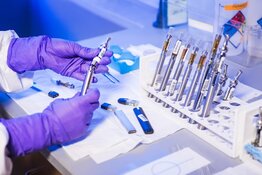The Life Sciences Report: We had a major transition in drug development when Dendreon Corp. (DNDN:NASDAQ) autologous cellular immunotherapy Provenge (sipuleucel-T) was approved for metastatic, castrate-resistant prostate cancer at the end of April 2010. That was only five years ago, and now the company is history. Because it was an autologous therapy, the product was cumbersome to manufacture and expensive for patients. Adding insult to injury, a couple of small molecules came along that were more efficacious than Provenge. Will new immunotherapies coming through today's pipelines continue to be supplanted by the newest thing, or will we begin to see a more traditional product life cycle?
George Zavoico: This is an unusual case in that Xtandi (enzalutamide) and Zytiga (abiraterone acetate), both orally administered small molecule drugs, outperformed Provenge. On the one hand, this speaks to how small molecules, and perhaps even traditional chemotherapies, like the taxanes and platinums, aren't going to go away. Instead, I think they will be part of cancer therapy for many years to come. What will change is the way they will be used, both sequentially and in combination, as immunotherapies come into play. There are still quite a few small molecule targets that are being exploited as we speak, including how some of them may serve to alter the tumor microenvironment to make immunotherapy more effective and safer.
"Inovio Pharmaceuticals Inc. has a broad platform that includes an IL-12 DNA vaccine and other DNA vaccines for both cancer and infectious diseases."
But you're right: There's no denying the real excitement has shifted into immuno-oncology, as evidenced at both the American Society of Clinical Oncology (ASCO) and the American Association for Cancer Research (AACR) meetings this year and at ASCO last year. The attraction of immunotherapies—whether small molecules or biologics—is that we are seeing durable responses that last for years in a substantial proportion of patients. I'm referring to the longer-term survival plateau—or tail, in Kaplan-Meier curves—that is almost never seen with drugs that don't target the immune system. I hesitate to say it, but we are arguably seeing cures—or at least something close to a cure. That's why the excitement is now shifting to the newly approved immune checkpoint inhibitors and various types of cancer vaccines—the descendants of Provenge—and now the chimeric antigen receptors (CAR) T-cell therapies, which add another level of complexity in their generation and production.
TLSR: Sticking with the Provenge model for a moment, that product reached peak revenue in 2014 with $300 million ($300M), but margins were terrible and Dendreon filed for Chapter 11 protection in November 2014. You just mentioned the complexity of CAR T-cell manufacturing. Will these new agents be able to surmount the problem of margins?
GZ: That's clearly the question that a lot of people have been asking. In some ways, Dendreon was ahead of its time, and therefore a lot of the culturing, cell expansion and genetic engineering technologies really hadn't been perfected or optimized as yet. I think some of the newer companies involved in the CAR T-cell space, such as Kite Pharma (KITE:NASDAQ), Juno Therapeutics (JUNO:NASDAQ), Oxford BioMedica (OXB:LSE) and Cellectis (ALCLS:Paris) have been working on exactly that aspect of CAR T-cell development and production. From what I've seen—and I'm not a production specialist or cell culture specialist—these companies seem to have made progress, and they are certainly moving forward with the belief that they will be able to surmount some of the problems Dendreon had. Having said that, I believe CAR T-cell therapy is still going to be a rather expensive approach with a higher cost of goods than regular biologics.
TLSR: George, when you look at cost, do you have to take into account efficacy? For instance, Gilead Sciences Inc.'s (GILD:NASDAQ) Sovaldi (sofosbuvir) costs about $84,000 ($84K), but it can actually cure a patient with hepatitis C in 12 weeks, and that's without coadministration of interferon. If these immunotherapies offer superior efficacy and potentially cure some patients, can they command premium pricing?
GZ: Absolutely. If you can effect a cure of sorts with something that has a $100K—or even a $200K—price tag, then, yes, that would be advantageous over chronic therapy that is probably not a cure and costs more than $200K over the remaining life of the patient, especially if you take into account the high cost of terminal care and lost productivity due to an earlier death. Efficacy and durability of response definitely come into play, and that will affect the ultimate cost of the product. It will be interesting to see how the discussion goes between the drug developers and third-party payers. There is some precedent, however, with drugs like Alexion's Soliris (eculizumab), for treating certain orphan indications. These are some of the most expensive drugs out there.
TLSR: We've seen some big Phase 3 immunotherapy failures. During the last two years, we saw GlaxoSmithKline's (GSK:NYSE) MAGE-A3 vaccine in non-small lung cell cancer fail, and we saw Oncothyreon Inc.'s (ONTY:NASDAQ) tecemotide (L-BLP25) go down in non-small lung cancer. Also, Vical Inc.'s (VICL:NASDAQ) Allovectin-7 failed in melanoma. These trials were based on promising and informative Phase 2 data. Given this, how much risk do investors face today in development-stage immunotherapy companies?
GZ: A lot of those failures happened before some of the more recent successes, particularly with the now approved immune checkpoint inhibitors— Bristol-Myers Squibb Co.'s (BMY:NYSE) antibodies Yervoy (ipilimumab) and Opdivo (nivolumab), and Merck & Co. Inc.'s (MRK:NYSE) antibody Keytruda (pembrolizumab). MAGE-A3 and tecemotide were cancer vaccines that targeted a single tumor antigen, while Allovectin-7 was an immunotherapeutic designed to sensitize the immune system to tumor antigens. I don't believe the problem is with the basic cancer vaccine or immunotherapeutic approach, but with the chosen targets. Since these failed drugs entered the clinic many years ago, we've learned so much more about how tumors induce immunosuppression, as well as how to overcome that.
Nevertheless, there will always be risk in biotech and pharma—there's no question about that. But I think going forward, the risks are diminishing in certain areas of immuno-oncology. For example, with CAR T-cells, which have already demonstrated remarkable efficacy in early-stage studies, if companies like Kite and Juno can demonstrate that their cost of goods is going to be fairly reasonable, that they can deliver a product reproducibly, and that the product is of sufficient quality and quantity, then I think the risks will be mitigated. But all of that remains to be seen.
"The way traditional chemotherapies will be used, both sequentially and in combination, will change as immunotherapies come into play."
We have CAR T-cell therapies right now in Phase 2 and Phase 2/3 trials, so we'll know the story on them within a year or two. In the immune checkpoint space, I think the risks are less now that Yervoy, Opdivo and Keytruda have actually hit the market. But all of these have limited effectiveness in that they provide durable responses in only about 20–30%—maybe 40%—of patients, depending on the cancer and whether they were combined with other types of drugs. I see this as a tremendous opportunity in the sense that a lot of the conversation at ASCO was about how to improve on that 20–30% durable response rate. There is considerable confidence that this can be accomplished, mainly from promising preclinical and some early-stage clinical trials.
A lot of progress has been made in combination therapies, with both other immune checkpoint inhibitors and with some standard chemotherapeutic agents, like taxanes and platinums, and also with targeted agents. Once the first steps have been taken in that direction, then the subsequent steps for combination therapy are probably less risky overall, provided the rationale for the combination makes sense and doesn't have additive or cumulative toxicity.
In addition, there was consensus that as yet there are no reliable biomarkers that can predict the likelihood of response to immunotherapies. PD-L1 expression appears to predict response to PD-1 inhibitors, but it is not a very specific measure. Low expressers may still respond to PD-1 inhibitors and some high expressers may not, which suggests that PD-L1 expression may vary considerably within a tumor and that biopsy specimens may not accurately measure expression levels in the whole tumor.
TLSR: Novartis AG (NVS:NYSE) made a huge upfront payment of $200M to Aduro Biotech Inc. (ADRO:NASDAQ) for its platform. Can we start to extrapolate comparables from that kind of deal activity, or is this a one-off kind of thing?
GZ: It's not really a one-off. In November 2014, Pfizer Inc. (PFE:NYSE) said it would pay Merck KGaA (MKGAY:OTCPK) $850M upfront to jointly develop a checkpoint inhibitor, and Merck KGaA would be able to receive both development and commercial milestones that could be worth up to $2 billion. Both pharmas would pay for development and commercialization of any checkpoint inhibitors—both anti-PD-L1 or anti-PD-1—that are developed. Revenues would be shared equally. The larger pharmaceutical companies that aren't in this space yet want to get in, and those that are already in want to strengthen or broaden their franchises. As these therapies are developed and begin to prove their efficacy, whether they are novel immunotherapies that may deliver the same durable responses, such as Keytruda and Opdivo as monotherapies, or in combination with immunotherapies, I think we will see more top-money deals of that sort.
"We are arguably seeing cures; that's why the excitement is shifting to immune checkpoint inhibitors and cancer vaccines."
To elaborate on that point, and getting back to the story of Provenge and how it laid the foundation for other cancer vaccines, Aduro's product is a cancer vaccine based on the Listeria bacterium, which has been rendered safe by the deletion of two genes essential to its pathogenicity, and then further genetically engineered to synthesize recognized tumor antigens. The modified Listeria is avidly taken up by dendritic cells, which then synthesize and present the tumor antigens to CD4+ and CD8+ T cells of the immune system. Despite Provenge's failure, other cancer vaccine companies, such as Northwest Biotherapeutics Inc. (NWBO:OTC) and Asterias Biotherapeutics Inc. (AST:NYSE.MKT), were not discouraged from developing their own cancer vaccines based on their intellectual property. Both of these companies are developing dendritic cell vaccines. In my mind, the investors who lost a lot of money in betting the wrong way on Dendreon were discouraged. Fortunately, there appear to be many ways to stimulate the immune system to recognize, attack and eliminate tumors.
Northwest Biotherapeutics' product, DCVax, is an autologous, partially activated dendritic cell vaccine that is modified to express multiple antigens derived from a patient's own tumor. At ASCO this year, Northwest Biotherapeutics presented interim results showing prolonged survival of patients with a variety of different tumors. The Asterias dendritic cell vaccine, AST-VAC2, targets telomerase, which tumor cells need to maintain their ability to proliferate indefinitely. AST-VAC2 is an allogeneic vaccine. If it proves to be effective, it will be an "off-the-shelf" vaccine that will obviate the need for harvesting dendritic cells from patients. Asterias is also developing an autologous version called AST-VAC1, which recently demonstrated promising prolonged relapse-free survival in a Phase 2 results in acute myeloid leukemia.
Advaxis Inc. (ADXS:OTCBB) has another Listeria-based platform for cancer vaccines. Oxford BioMedica has an anti-5T4 vaccine that uses a Vaccinia virus instead of the Listeria bacterium as a vector to look at other tumor antigens; the 5T4 is a broadly expressed tumor antigen in a number of cancers. Results from larger clinical trials are necessary before any of these products will be approved by the FDA or European Medicines Agency (EMA), assuming the results are positive, of course.
Provenge proved that if you target an antigen, you can get a response. The question is finding the right tumor antigen or antigens, and finding the right indication, so that you can get the vaccine into the patient when there is still plenty of time to see a response—and then, hopefully, a durable response.
TLSR: Have you picked a winner between the T-cell space and the checkpoint inhibitor space?
GZ: That's a really good question. There are still quite a lot of companies in the running with those platforms, so I hesitate to pick a winner. Each platform should be looked at and kept on the radar screen. Maybe choosing a basket of stocks of companies active in this space may mitigate risk.
As for the ultimate winners—and I think there will be several—it's all going to be data driven. Who gets there first, with the best data for a particular cancer, may win that in space, but not another. In the CAR T-cell space, not all the contenders are going for the same cancer with the same antigen. This space is moving more as a tide, rather than following a single leader or two, even though Kite and Juno both have CAR T cells targeting CD19 for the treatment of B-cell malignancies.
"CAR T-cell therapy is going to be a rather expensive approach."
Having said that, if you're not in the immune checkpoint space right now with an antibody you'd better jump in, because every therapy going forward is going to be compared to the PD-1 or the PD-L1 inhibitors. There is the possibility that another checkpoint may emerge that may have the same sort of efficacy as the PD-1 inhibitor by itself. PD-1 may have just been the first of the low-hanging fruit. There may be other checkpoints, like OX40, LAG-3 or TIM-3, which may be effective in producing durable responses at a rate of 20–30%. A number of these immune checkpoints are being examined.
TLSR: George, what other companies are targeting immune checkpoints?
GZ: Phosphatidylserine (PS) is an immune checkpoint being targeted by Peregrine Pharmaceuticals Inc.'s (PPHM:NASDAQ) antibody bavituximab, which is in a Phase 3 clinical trial in non-small cell lung cancer (NSCLC). PS is now becoming recognized as an upstream checkpoint inhibitor, one of the first that triggers an immune response. In this regard, it could synergize with Yervoy, Keytruda or Opdivo. To this end, Peregrine commenced a Phase 1 trial of bavituximab combined with Yervoy in advanced melanoma, and is planning a Phase 2 trial of bavituximab combined with Opdivo for NSCLC.
Agenus Inc. (AGEN:NASDAQ) is developing a number of immune checkpoint inhibitors in partnership with Incyte Corp. (INCY:NASDAQ). These are GITR, OX40, TIM-3 and LAG-3. Compugen Ltd. (CGEN:NASDAQ), an Israeli company, has discovered 11 new checkpoints that haven't been targeted or even described by anybody else. Two of these are partnered with Bayer AG (BAYRY:OTCMKTS; BAYN:XETRA). Immune checkpoint product candidates from these two companies should enter clinical trials within a year or two. I should also mention that Agenus is also developing autologous heat shock protein-based cancer vaccines that it calls Prophage G-100 and G-200, which are now in Phase 2 trials for glioblastoma.
TLSR: When will we begin to know what the future may look like? When will we see results that might guide us forward?
GZ: In the next year or two we could see some results that will be indicative of the future of these technology platforms. We already feel quite confident that immune checkpoint inhibitors will play an increasingly important role in the treatment of cancer.
This space is enlarging. I think a lot of checkpoints can be targeted. As I have said, the puzzle will be to find the cancers that are most effectively targeted by each inhibitor, and whether combination therapy will improve outcomes. Another part of that puzzle is to identify effective biomarkers that will be predictive of a response to each immune checkpoint inhibitor.
"Efficacy and durability of response definitely will affect the ultimate cost of the product."
I think cancer vaccines, whether they be dendritic cell or tumor cell antigen vaccines, will emerge as effective therapies in two to four years, either alone or in combination. CAR T-cell therapy, due to its cost and complex logistics, may at first be reserved for patients with late-stage cancers. An interesting question, in my mind, is whether immune therapy with checkpoint inhibitors and/or vaccines, perhaps in combination with small molecule drugs and more traditional biologics, will be as effective, or more effective, as CAR T-cell therapies.
TLSR: Are there any novel platforms that appear extraordinary to you?
GZ: One of the other exciting developments in the immuno-oncology space has been direct activation of T cells already in the patient. This is exemplified by the approval of Amgen Inc.'s (AMGN:NASDAQ) antibody Blincyto (blinatumomab) for Philadelphia chromosome-negative refractory acute lymphocytic leukemia. This is a bispecific antibody: In other words, it has two binding domains, one for the antigen CD3, which is a T-cell receptor, and the other for a tumor cell antigen, in this case CD19. Blinatumomab is another example of a successful immunotherapy, and it underscores what can happen when you effectively activate the immune response. You can kill tumor cells. Amgen has shown us that it works.
"Another part of that puzzle is to identify effective biomarkers that will be predictive of a response to each immune checkpoint inhibitor."
Another name is Emergent BioSolutions Inc. (EBS:NYSE), which has another bispecific antibody, MOR209/ES414, that emerged from its ADAPTIR antibody discovery platform. This is a humanized biologic for the treatment of metastatic castration-resistant prostate cancer, targeting prostate-specific membrane antigen (PSMA) and CD3. It acts similarly to Blincyto in that it directs effector T cells to kill PSMA-expressing prostate cancer cells. In a way, this is a follow-on to Provenge, but incorporating new technologies that weren't available when Provenge was being developed. It's differentiated from Provenge in being a biologic and not an autologous cell therapy, and Emergent Biosolutions has optimized its structure and its pharmacokinetics such that the therapy has a prolonged serum half-life. MorphoSys AG (MOR:FSE; MPSYF:OTCPK) of Munich, Germany, partnered with Emergent Biosolutions to develop MOR209/ES414, which began a Phase 1 clinical trial earlier this year.
TLSR: What about DNA vaccines? We have seen this technology get some attention from the market.
GZ: I'd like to mention OncoSec Medical Inc. (ONCS:NASDAQ). One of the things that may substantially improve the outcome of immunotherapeutic agents is to prime the tumor's microenvironment to make it more amenable to removal or blockade of these checkpoints, to attract more tumor infiltrating leukocytes, and to induce a switch in tumor-associated macrophages (TAMs) from an immunosuppressive to an immunostimulatory phenotype. OncoSec Medical has a DNA vaccine that is administered with electroporation directly into the tumor. An electrical impulse is applied to the tumor together with the DNA vaccine, which enters tumor cells through transient membrane pores created by the applied electric field. Once inside the cell, the DNA produces interleukin-12 (IL-12), a cytokine that modifies the tumor microenvironment from an immunosuppressive to an immunostimulatory state. In effect, IL-12 is an immune activator that helps stimulate a local immune response that I think would be amplified if used in combination with an anti-PD-1 antibody. OncoSec's intratumoral plasmid IL-12 DNA vaccine is in four Phase 2 trials for Merkel cell cancer, cutaneous T-cell lymphoma, malignant melanoma and squamous cell carcinoma of the head and neck. A Phase 2 clinical trial in melanoma showed that the product can induce tumor regression in a substantial proportion of patients.
TLSR: OncoSec and Inovio Pharmaceuticals Inc. (INO:NASDAQ) have a similar platform. They both have a DNA vaccine, and they both use electroporation. They both utilize IL-12 as an activator. Could you comment?
GZ: OncoSec is largely focused on oncology indications for its IL-12 DNA vaccine, while it continues to explore other immunomodulatory targets in preclinical studies. It is also planning to start a combination study in melanoma with Keytruda within the next month or so.
Inovio, on the other hand, has a broader platform that does include an IL-12 DNA vaccine, but also several other DNA vaccines for both cancer and infectious diseases. These include DNA vaccines designed to produce specific tumor antigens or immune activators, such as IL-12, as well as functional monoclonal antibodies targeting certain viral antigens.
Last year, Inovio reported positive results from a Phase 2 trial of its vaccine, called VGX-3100, targeting certain human papillomavirus (HPV) antigens in patients with high grade cervical intraepithelial neoplasia (cervical dysplasia) caused by HPV types 16 or 18. The study showed that VGX-3100 induced a robust T-cell response, just what it was designed to do. In my view, there's really not much overlap between the pipelines of these two companies.
TLSR: Thank you. Always a pleasure.
Dr. George Zavoico, senior equity analyst at JonesTrading Institutional Services LLC, has more than 10 years of experience as a life sciences equity analyst writing research on publicly traded equities. His principal focus is on biotechnology, biopharmaceutical, specialty pharmaceutical and molecular diagnostics companies. Previously, Zavoico was a senior equity research analyst in the healthcare sector at MLV & Co., and an equity analyst at Cantor Fitzgerald and Westport Capital Markets. Prior to becoming an equity analyst, Zavoico established his own consulting company serving the biotech and pharmaceutical industries, providing competitive intelligence and marketing research, due diligence services and guidance in regulatory affairs. Zavoico began his career as a senior research scientist at Bristol-Myers Squibb Co., moving on to management positions at Alexion Pharmaceuticals Inc. and T Cell Sciences Inc. (now Celldex Therapeutics Inc.). Zavoico has a bachelor's degree in biology from St. Lawrence University and a Ph.D. in physiology from the University of Virginia. He held post-doctoral fellowships at the University of Connecticut School of Medicine and Harvard Medical School/Brigham & Women's Hospital. He has published more than 30 papers in peer-reviewed journals and has coauthored four book chapters. He received the Financial Times/Starmine Award two years in a row for being among the top-ranked earnings estimators in the biotechnology sector.
Read what other experts are saying about:
Want to read more Life Sciences Report interviews like this? Sign up for our free e-newsletter, and you'll learn when new articles have been published. To see a list of recent interviews with industry analysts and commentators, visit our Streetwise Interviews page.
DISCLOSURE:
1) Dr. George S. Mack conducted this interview for Streetwise Reports LLC, publisher of The Gold Report, The Energy Report and The Life Sciences Report, and provides services to Streetwise Reports as an independent contractor. He owns, or his family owns, shares of the following companies mentioned in this interview: Inovio Pharmaceuticals Inc.
2) The following companies mentioned in the interview are sponsors of Streetwise Reports: Inovio Pharmaceuticals Inc. The companies mentioned in this interview were not involved in any aspect of the interview preparation or post-interview editing so the expert could speak independently about the sector. Streetwise Reports does not accept stock in exchange for its services.
3) George Zavoico: I own, or my family owns, shares of the following companies mentioned in this interview: None. I personally am, or my family is, paid by the following companies mentioned in this interview: None. My company has a financial relationship with the following companies mentioned in this interview: None. I was not paid by Streetwise Reports for participating in this interview. Comments and opinions expressed are my own comments and opinions. I determined and had final say over which companies would be included in the interview based on my research, understanding of the sector and interview theme. I had the opportunity to review the interview for accuracy as of the date of the interview and am responsible for the content of the interview.
4) Interviews are edited for clarity. Streetwise Reports does not make editorial comments or change experts' statements without their consent.
5) The interview does not constitute investment advice. Each reader is encouraged to consult with his or her individual financial professional and any action a reader takes as a result of information presented here is his or her own responsibility. By opening this page, each reader accepts and agrees to Streetwise Reports' terms of use and full legal disclaimer.
6) From time to time, Streetwise Reports LLC and its directors, officers, employees or members of their families, as well as persons interviewed for articles and interviews on the site, may have a long or short position in securities mentioned. Directors, officers, employees or members of their families are prohibited from making purchases and/or sales of those securities in the open market or otherwise during the up-to-four-week interval from the time of the interview until after it publishes.














































